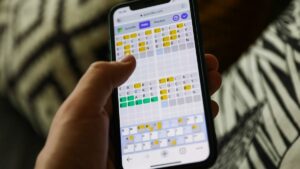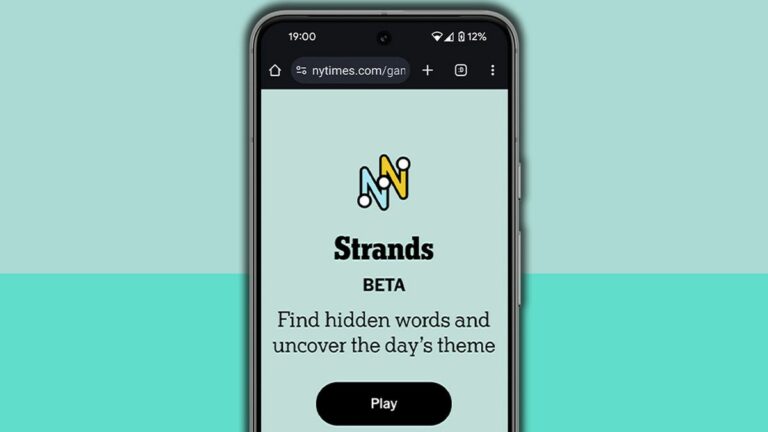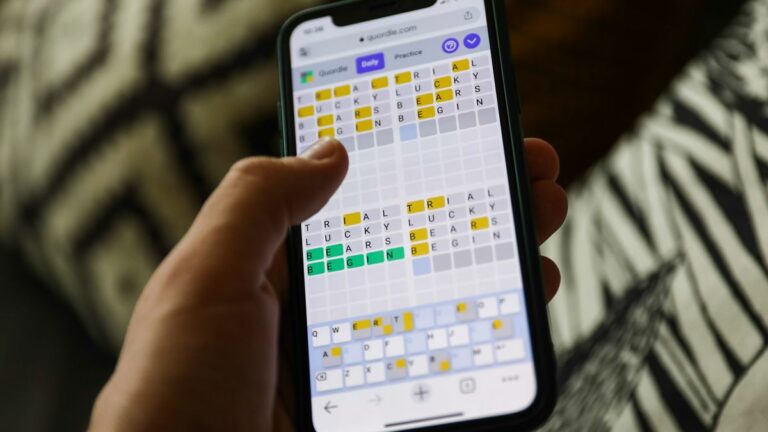Few things catch my attention more than getting asked to take a nap in the middle of my workday. I love naps, in particular power naps. They’re the perfect little resting time that gives me a boost to continue my day. So when I got invited to try out a headband designed to help you sleep on demand, I was excited to give it a go.
The headband, from a company called Elemind, is sleek and comfortable. At $349 (plus an optional subscription fee for access to your sleep data), it’s also really pricey. It packs in a lot of tech: EEG capabilities to read your brainwaves, AI that interprets and responds to that brain activity, and audio output to give you sleep-inducing sounds. The best way I can describe it is that it sounds like a low-pitch, rhythmic buzz you can also feel. It’s not intrusive or distracting; it almost feels like a light massage.
“It’s basically noise-canceling those brain waves that keep you awake,” Meredith Perry, cofounder of Elemind, tells me.
I’ve been working in the sleep industry for years and have tried all sorts of gadgets and products that claim to help you sleep better. Honestly, not many of them work like they’re intended to. Naturally, I was eager to see if the Elemind headband worked or if it would go to my list of products I’ve tested and have failed. Here’s what I found.
Putting the Elemind to the test
I arrived at The Crosby Street Hotel in New York for my nap. Perry greeted me at the entrance of the room and took the time to explain the technology behind Elemind and to show me how to properly put on the headband and turn it on. She also showed me how the app works and the data I can access when wearing the headband. Then she left me to nap.
I’ll briefly describe what happened next because — spoiler — I fell asleep. I remember lying down and hearing a low buzz that resembled bone conduction. I could hear the buzzing, but I could also feel it. At first, the rhythm was fast-paced, but as I started to drift off I felt it getting slower. The next thing I knew, I was waking up to the sound of the room door opening. It was Perry with a big smile because she knew the headband had worked based on my half-opened eyes and the bewildered look on my face.
The nap was pretty short. We set the headband to 25 minutes. This wasn’t my typical nap. Instead of a deep sleep, I felt like I was in an alpha state — like a light sleep where I was still aware of my surroundings.
When I woke up, I felt exactly how I normally feel after a nap, which was a little groggy. That feeling lasted only a few minutes, and I continued my day with no side effects or grogginess.
This is the first sleep tech device I’ve seen that targets brain waves and redirects them in real-time. Research affiliated with Elemind claims that 76% of the people who wore the headband fell asleep faster, and that was certainly the case for me.
What the data says
According to the data I received from my nap, which was reviewed by neuroscientists at Elemind, my alpha wave activity remained high during my nap, which indicates that while I was resting and in light sleep, I didn’t go into a deep sleeping stage. I suspected that would be the case for a 25-minute nap, and that also aligns with my experience wearing the headband. (I was aware of my surroundings but in a light sleep, kind of like how you feel when you’re about to wake up in the morning.)
The image above, which Elemind refers to as a plot, is a polar histogram that shows the performance of the headband while tracking my alpha waves. On the left side, the plot shows the target onset phase and the distribution of all the stimuli (gray bars). The right side is a similar plot but for the target stimulus offset phase.
More simply put, “the onset [is] the phase of the brainwave when each sound pulse starts and offset is the phase of the brainwave when each sound pulse ends,” said Ryan Neely, VP of science and research at Elemind. All of this means that the headband was working as intended (more pulses at the beginning when my brainwave activity was high, then, less frequently when my target brainwave activity was reached (224 degrees).
The data confirms what I felt during my nap — that I had a light sleep nap. I certainly felt like I was resting and also felt I fell asleep pretty fast (what I felt was only about a few minutes). I’d say it was a pretty good power nap, especially since it was only 25 minutes long at 2 p.m. I’m curious to see if it’ll induce me into a more deep sleep during the night when I’m in the comfort of my home.
How does the Elemind work?
The headband is designed to help users fall asleep by targeting their alpha wave activity with sound pulses. This is a core feature of the patented algorithm that was developed at MIT and built into each band. Perry explained that the headband uses noninvasive neuromodulation technology to track your EEG brain activity and deliver acoustic stimulation synced to your brain’s natural rhythms, in actual time. Every night you wear the headband, it learns more and evolves with you through its AI capabilities, becoming more effective with time.
The AI behind the headband, which Elemind refers to as Sleep Tailor, learns your unique brain activity and sleep patterns to improve your rest. It gathers your sleep data and analyzes it to generate stimulation patterns to offset your brain activity.
The headband can be worn all night and is comfortable enough to wear in all sleeping positions. Users can use Elemind in any way that suits their needs. For example, you can wear the headband just to fall asleep and take it off during the night, or you can choose to put the headband on only if you wake up and need help falling back to sleep. You can also use Elemind to nap during the day.
To experience all of the Elemind’s features, it’s recommended that you wear it all night. You’ll be able to use it to help you fall asleep, with real-time sleep staging, which will result in a comprehensive sleep report post-session, and to fall back asleep faster if you wake up up earlier than intended. Soon, the Elemind will also have a deep sleep stimulation feature, which will amplify delta waves during slow-wave sleep.
Is the Elemind comfortable?
I found the Elemind headband to be comfortable. It’s made of soft material and it’s adjustable in the back so you can make it tighter or looser as you prefer it. It should be tight enough that it doesn’t fall off, but not tight enough that it’s uncomfortable to sleep with. I mostly napped on my back, so I didn’t have any issues with it sliding off. I did briefly lay on my side and couldn’t feel it shifting or bunching up.
For accurate readings, you only need to ensure that the sensors are in contact with your forehead. If you have long hair, Perry recommends wrapping it around your neck and under the hair, then gently sliding it up to your forehead and behind your ears.
Is the Elemind worth it?
Whether the Elemind headband would be worth the $349 to you will depend on a few factors.
You might like Elemind if:
- You travel often and struggle with jetlag
- You find it difficult to fall sleep
- You wake up frequently during the night and struggle to fall back asleep
Elemind might not be for you if:
- You find a subtle buzz on your forehead too distracting
- You don’t have issues falling asleep or staying asleep
Where can I buy the Elemind headband?
You can preorder the Elemind on its website. According to Perry, the headbands that are part of the company’s beta program have already started to ship out and those preordered in December will ship starting in January.
In addition to the $349 price tag for the device, there’s an optional membership to access sleep tracking, scores and metrics. Without the membership, you can still access the headband’s core features of falling asleep and falling back to sleep faster. You do get the first month free with the purchase of the headband. You can choose to pay the membership annually, which will run you about $7 a month, or to pay it in monthly installments of $13.




















+ There are no comments
Add yours